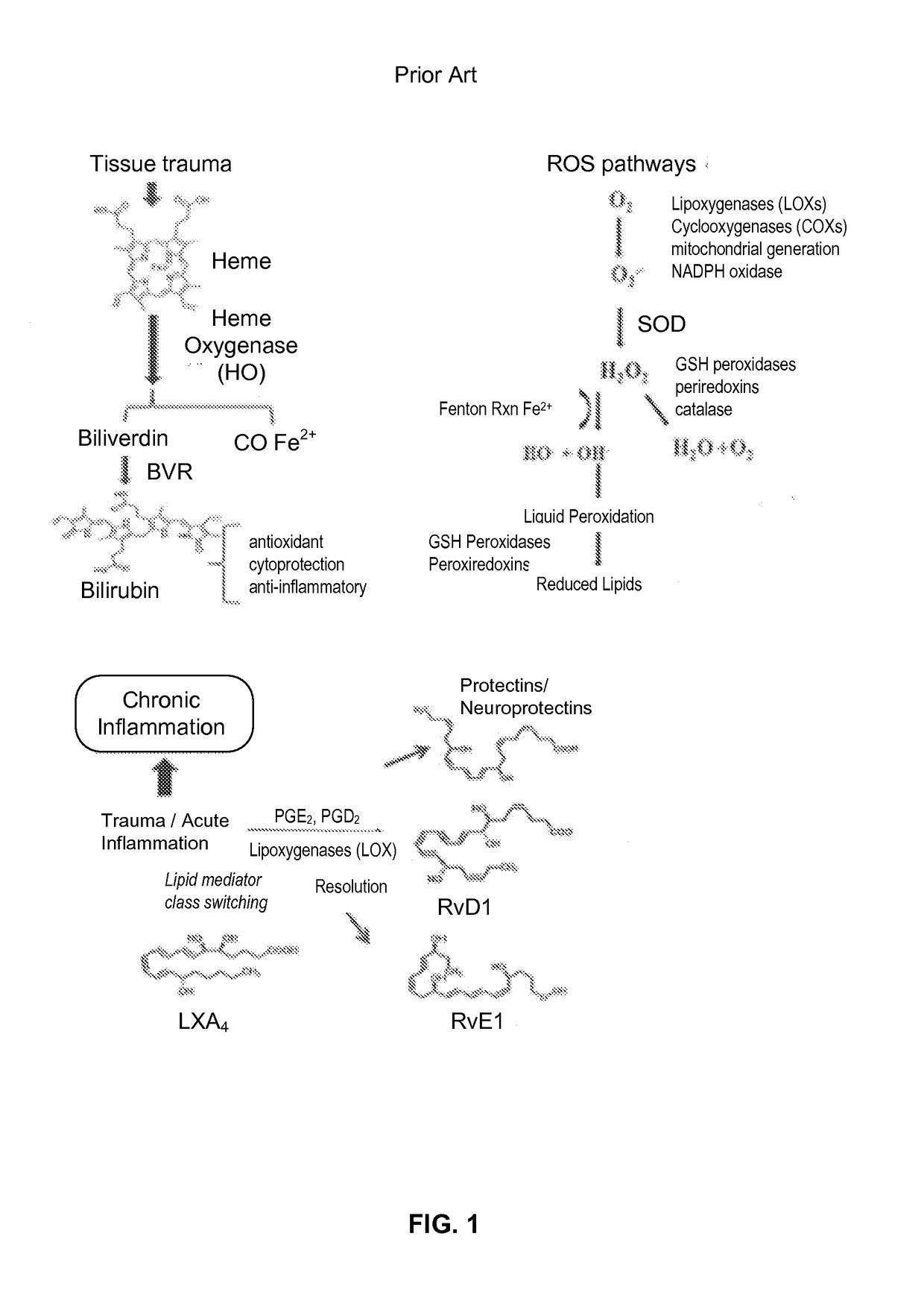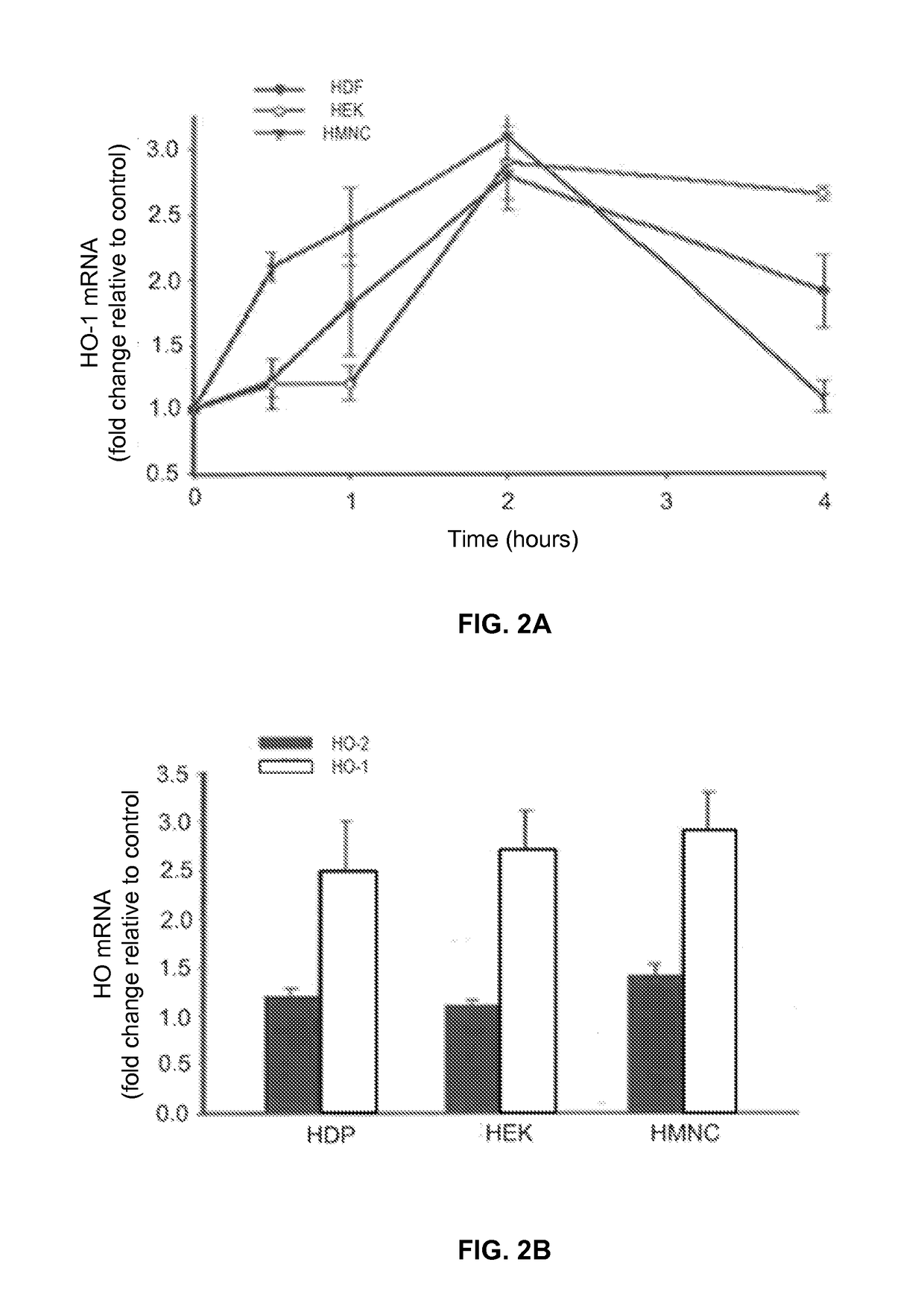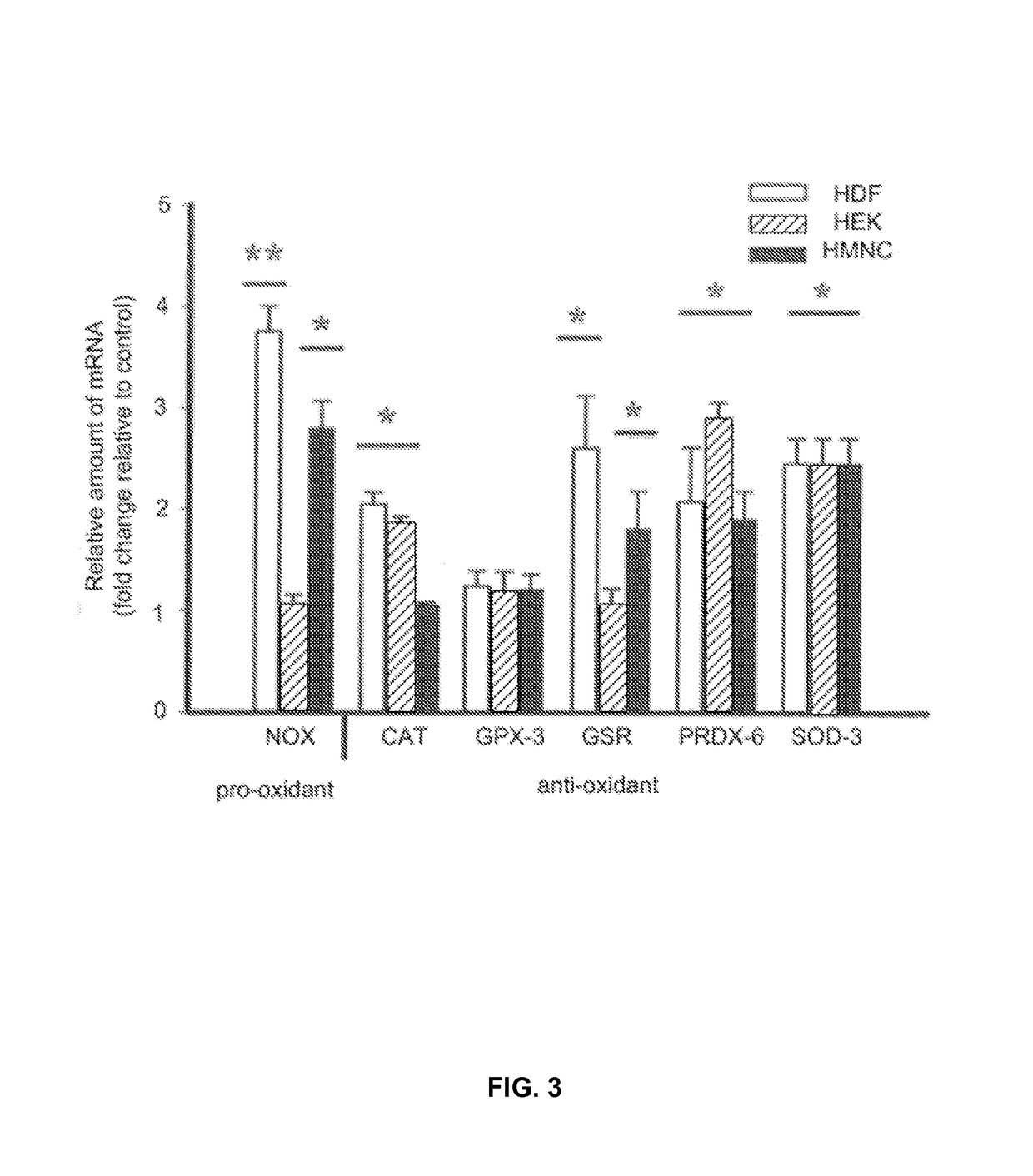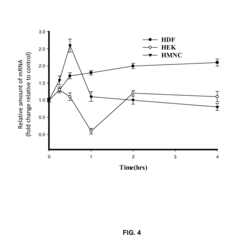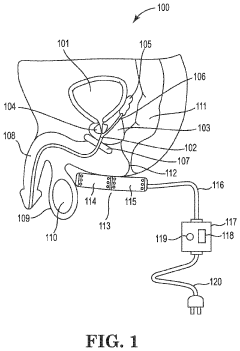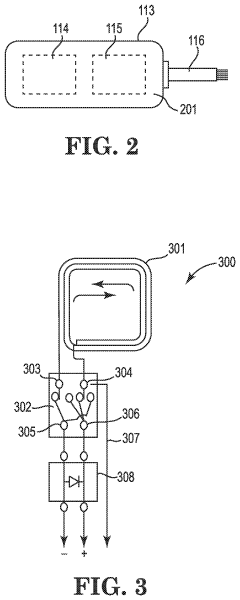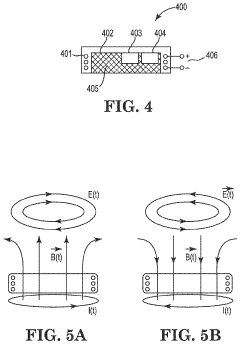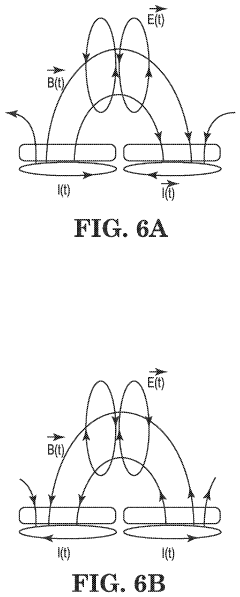The Role of PEMF Therapy in Chronic Disease Prevention
AUG 11, 20259 MIN READ
Generate Your Research Report Instantly with AI Agent
Patsnap Eureka helps you evaluate technical feasibility & market potential.
PEMF Therapy Background and Objectives
Pulsed Electromagnetic Field (PEMF) therapy has emerged as a promising non-invasive treatment modality in recent years, gaining attention for its potential role in chronic disease prevention and management. The technology harnesses the power of electromagnetic fields to stimulate cellular activity and promote healing processes within the body. PEMF therapy's roots can be traced back to the mid-20th century, with early applications in bone healing and pain management.
As research in this field has progressed, the scope of PEMF therapy has expanded to encompass a wider range of chronic conditions, including cardiovascular diseases, neurological disorders, and musculoskeletal issues. The growing interest in PEMF therapy stems from its ability to address underlying cellular dysfunction, which is often a common factor in various chronic diseases.
The evolution of PEMF technology has been marked by significant advancements in device design, treatment protocols, and understanding of the biological mechanisms involved. Modern PEMF devices offer precise control over field strength, frequency, and waveform, allowing for tailored treatments that target specific physiological processes.
The primary objective of PEMF therapy in chronic disease prevention is to enhance cellular function and promote the body's natural healing mechanisms. By improving circulation, reducing inflammation, and supporting cellular energy production, PEMF therapy aims to address the root causes of many chronic conditions before they progress to more severe stages.
Another key goal is to provide a complementary or alternative treatment option that minimizes the need for pharmaceutical interventions, potentially reducing the risk of side effects associated with long-term medication use. This aligns with the growing trend towards holistic and preventive healthcare approaches.
Research objectives in the field of PEMF therapy for chronic disease prevention include identifying optimal treatment parameters for various conditions, elucidating the molecular and cellular mechanisms of action, and conducting large-scale clinical trials to establish efficacy and safety profiles. There is also a focus on developing more accessible and user-friendly PEMF devices for home use, which could significantly expand the reach and impact of this technology.
As the healthcare landscape continues to shift towards preventive strategies, PEMF therapy holds promise as a versatile tool in the management of chronic diseases. The ongoing technological advancements and expanding body of clinical evidence suggest that PEMF therapy may play an increasingly important role in future healthcare paradigms, offering a non-invasive, drug-free approach to maintaining health and preventing the onset or progression of chronic conditions.
As research in this field has progressed, the scope of PEMF therapy has expanded to encompass a wider range of chronic conditions, including cardiovascular diseases, neurological disorders, and musculoskeletal issues. The growing interest in PEMF therapy stems from its ability to address underlying cellular dysfunction, which is often a common factor in various chronic diseases.
The evolution of PEMF technology has been marked by significant advancements in device design, treatment protocols, and understanding of the biological mechanisms involved. Modern PEMF devices offer precise control over field strength, frequency, and waveform, allowing for tailored treatments that target specific physiological processes.
The primary objective of PEMF therapy in chronic disease prevention is to enhance cellular function and promote the body's natural healing mechanisms. By improving circulation, reducing inflammation, and supporting cellular energy production, PEMF therapy aims to address the root causes of many chronic conditions before they progress to more severe stages.
Another key goal is to provide a complementary or alternative treatment option that minimizes the need for pharmaceutical interventions, potentially reducing the risk of side effects associated with long-term medication use. This aligns with the growing trend towards holistic and preventive healthcare approaches.
Research objectives in the field of PEMF therapy for chronic disease prevention include identifying optimal treatment parameters for various conditions, elucidating the molecular and cellular mechanisms of action, and conducting large-scale clinical trials to establish efficacy and safety profiles. There is also a focus on developing more accessible and user-friendly PEMF devices for home use, which could significantly expand the reach and impact of this technology.
As the healthcare landscape continues to shift towards preventive strategies, PEMF therapy holds promise as a versatile tool in the management of chronic diseases. The ongoing technological advancements and expanding body of clinical evidence suggest that PEMF therapy may play an increasingly important role in future healthcare paradigms, offering a non-invasive, drug-free approach to maintaining health and preventing the onset or progression of chronic conditions.
Market Analysis for PEMF in Chronic Disease Prevention
The market for Pulsed Electromagnetic Field (PEMF) therapy in chronic disease prevention is experiencing significant growth, driven by increasing awareness of non-invasive treatment options and the rising prevalence of chronic diseases worldwide. The global PEMF therapy devices market is projected to expand at a compound annual growth rate (CAGR) of over 7% from 2021 to 2028, with the chronic disease prevention segment playing a crucial role in this growth.
Chronic diseases, including cardiovascular disorders, diabetes, arthritis, and chronic pain conditions, represent a substantial burden on healthcare systems globally. As traditional treatment methods often come with side effects and limited long-term efficacy, there is a growing demand for alternative therapies like PEMF. This shift in patient preferences towards non-pharmacological interventions is a key driver for the PEMF market in chronic disease prevention.
The market is segmented based on application areas, with musculoskeletal disorders and pain management currently dominating the PEMF therapy landscape. However, there is increasing interest in the potential of PEMF for preventing and managing other chronic conditions, such as cardiovascular diseases and neurological disorders. This diversification of applications is expected to create new market opportunities and drive further growth.
Geographically, North America holds the largest market share due to high healthcare expenditure, advanced medical infrastructure, and greater awareness of PEMF therapy. Europe follows closely, with countries like Germany and the UK showing significant adoption rates. The Asia-Pacific region is anticipated to witness the fastest growth, fueled by improving healthcare access, rising disposable incomes, and a large patient pool with chronic diseases.
The market is characterized by a mix of established medical device companies and specialized PEMF therapy providers. Key players are investing heavily in research and development to enhance the efficacy of PEMF devices and expand their application range. There is also a trend towards the development of portable and home-use PEMF devices, which is expected to broaden the market reach and increase patient accessibility.
Challenges in the market include the need for more extensive clinical evidence to support PEMF's efficacy in chronic disease prevention, regulatory hurdles in some regions, and the high initial cost of PEMF devices. However, ongoing research and technological advancements are gradually addressing these barriers, paving the way for wider adoption.
In conclusion, the market analysis for PEMF therapy in chronic disease prevention reveals a promising landscape with substantial growth potential. As the global burden of chronic diseases continues to rise, PEMF therapy is well-positioned to capture a significant share of the preventive healthcare market, offering a non-invasive, drug-free alternative for patients seeking long-term health management solutions.
Chronic diseases, including cardiovascular disorders, diabetes, arthritis, and chronic pain conditions, represent a substantial burden on healthcare systems globally. As traditional treatment methods often come with side effects and limited long-term efficacy, there is a growing demand for alternative therapies like PEMF. This shift in patient preferences towards non-pharmacological interventions is a key driver for the PEMF market in chronic disease prevention.
The market is segmented based on application areas, with musculoskeletal disorders and pain management currently dominating the PEMF therapy landscape. However, there is increasing interest in the potential of PEMF for preventing and managing other chronic conditions, such as cardiovascular diseases and neurological disorders. This diversification of applications is expected to create new market opportunities and drive further growth.
Geographically, North America holds the largest market share due to high healthcare expenditure, advanced medical infrastructure, and greater awareness of PEMF therapy. Europe follows closely, with countries like Germany and the UK showing significant adoption rates. The Asia-Pacific region is anticipated to witness the fastest growth, fueled by improving healthcare access, rising disposable incomes, and a large patient pool with chronic diseases.
The market is characterized by a mix of established medical device companies and specialized PEMF therapy providers. Key players are investing heavily in research and development to enhance the efficacy of PEMF devices and expand their application range. There is also a trend towards the development of portable and home-use PEMF devices, which is expected to broaden the market reach and increase patient accessibility.
Challenges in the market include the need for more extensive clinical evidence to support PEMF's efficacy in chronic disease prevention, regulatory hurdles in some regions, and the high initial cost of PEMF devices. However, ongoing research and technological advancements are gradually addressing these barriers, paving the way for wider adoption.
In conclusion, the market analysis for PEMF therapy in chronic disease prevention reveals a promising landscape with substantial growth potential. As the global burden of chronic diseases continues to rise, PEMF therapy is well-positioned to capture a significant share of the preventive healthcare market, offering a non-invasive, drug-free alternative for patients seeking long-term health management solutions.
Current PEMF Technology Status and Challenges
Pulsed Electromagnetic Field (PEMF) therapy has gained significant attention in recent years for its potential role in chronic disease prevention. However, the current status of PEMF technology presents both promising advancements and notable challenges. Globally, PEMF devices have evolved from bulky, stationary units to more portable and user-friendly designs, making them increasingly accessible for home use. This technological progression has been driven by improvements in electromagnetic field generation, power efficiency, and miniaturization of components.
Despite these advancements, several key challenges persist in the field of PEMF technology. One major hurdle is the lack of standardization in treatment protocols. Different devices operate at varying frequencies, intensities, and waveforms, making it difficult to establish consistent guidelines for chronic disease prevention. This variability also complicates the comparison of research outcomes across different studies, hindering the development of evidence-based practices.
Another significant challenge lies in the limited understanding of the precise mechanisms by which PEMF therapy influences cellular processes and physiological systems. While numerous studies have demonstrated positive effects on inflammation, pain reduction, and tissue repair, the underlying molecular pathways remain incompletely elucidated. This knowledge gap impedes the optimization of PEMF parameters for specific chronic conditions and hampers the development of more targeted therapeutic approaches.
The regulatory landscape surrounding PEMF technology also presents challenges. In many countries, PEMF devices fall into a gray area between medical devices and wellness products, leading to inconsistent approval processes and marketing claims. This regulatory ambiguity can create confusion among healthcare providers and consumers, potentially limiting the adoption of PEMF therapy in mainstream medical practice for chronic disease prevention.
From a technological perspective, current PEMF devices face limitations in terms of battery life, treatment area coverage, and the ability to customize treatments for individual patient needs. Many devices require frequent recharging or connection to a power source, which can be inconvenient for long-term use in chronic disease management. Additionally, achieving uniform electromagnetic field distribution over larger body areas remains a challenge, particularly for conditions that affect multiple systems or larger anatomical regions.
The integration of PEMF technology with other therapeutic modalities and digital health platforms represents both an opportunity and a challenge. While there is potential for synergistic effects when combining PEMF with other treatments, the complexity of such integrations poses technical and clinical validation hurdles. Furthermore, the incorporation of PEMF data into broader health monitoring systems is still in its infancy, limiting the ability to track long-term outcomes and personalize treatments for chronic disease prevention.
In terms of geographical distribution, PEMF technology development and adoption show significant variations. North America and Europe lead in research and commercialization efforts, with a growing number of clinical trials and FDA-approved devices. However, access to advanced PEMF technologies remains limited in many developing countries, creating disparities in the potential for chronic disease prevention on a global scale.
Despite these advancements, several key challenges persist in the field of PEMF technology. One major hurdle is the lack of standardization in treatment protocols. Different devices operate at varying frequencies, intensities, and waveforms, making it difficult to establish consistent guidelines for chronic disease prevention. This variability also complicates the comparison of research outcomes across different studies, hindering the development of evidence-based practices.
Another significant challenge lies in the limited understanding of the precise mechanisms by which PEMF therapy influences cellular processes and physiological systems. While numerous studies have demonstrated positive effects on inflammation, pain reduction, and tissue repair, the underlying molecular pathways remain incompletely elucidated. This knowledge gap impedes the optimization of PEMF parameters for specific chronic conditions and hampers the development of more targeted therapeutic approaches.
The regulatory landscape surrounding PEMF technology also presents challenges. In many countries, PEMF devices fall into a gray area between medical devices and wellness products, leading to inconsistent approval processes and marketing claims. This regulatory ambiguity can create confusion among healthcare providers and consumers, potentially limiting the adoption of PEMF therapy in mainstream medical practice for chronic disease prevention.
From a technological perspective, current PEMF devices face limitations in terms of battery life, treatment area coverage, and the ability to customize treatments for individual patient needs. Many devices require frequent recharging or connection to a power source, which can be inconvenient for long-term use in chronic disease management. Additionally, achieving uniform electromagnetic field distribution over larger body areas remains a challenge, particularly for conditions that affect multiple systems or larger anatomical regions.
The integration of PEMF technology with other therapeutic modalities and digital health platforms represents both an opportunity and a challenge. While there is potential for synergistic effects when combining PEMF with other treatments, the complexity of such integrations poses technical and clinical validation hurdles. Furthermore, the incorporation of PEMF data into broader health monitoring systems is still in its infancy, limiting the ability to track long-term outcomes and personalize treatments for chronic disease prevention.
In terms of geographical distribution, PEMF technology development and adoption show significant variations. North America and Europe lead in research and commercialization efforts, with a growing number of clinical trials and FDA-approved devices. However, access to advanced PEMF technologies remains limited in many developing countries, creating disparities in the potential for chronic disease prevention on a global scale.
Existing PEMF Protocols for Chronic Diseases
01 PEMF devices for therapeutic applications
Pulsed Electromagnetic Field (PEMF) therapy devices are designed for various therapeutic applications. These devices generate electromagnetic fields to stimulate cellular activity and promote healing. They can be used for pain management, tissue repair, and improving overall well-being.- PEMF devices for therapeutic applications: Pulsed Electromagnetic Field (PEMF) therapy devices are designed for various therapeutic applications. These devices generate electromagnetic fields to stimulate cellular repair and regeneration, potentially alleviating pain and promoting healing in different parts of the body. The technology can be applied through various apparatus designs, including wearable devices and treatment systems for specific body areas.
- PEMF therapy for pain management and tissue healing: PEMF therapy is utilized for managing pain and accelerating tissue healing. The electromagnetic pulses are believed to reduce inflammation, improve circulation, and stimulate cellular repair processes. This non-invasive treatment method can be applied to various conditions, including musculoskeletal injuries, chronic pain, and post-surgical recovery, offering an alternative or complementary approach to traditional pain management techniques.
- Integration of PEMF technology in wearable devices: PEMF therapy is being integrated into wearable devices, allowing for portable and convenient treatment options. These wearable PEMF devices can be designed for specific body parts or as full-body systems, enabling users to receive therapy while engaging in daily activities. The integration of PEMF technology in wearables aims to improve treatment adherence and provide more consistent therapeutic benefits.
- PEMF therapy in veterinary and agricultural applications: The application of PEMF therapy extends beyond human medicine to veterinary care and agricultural practices. PEMF devices are being developed for use in treating animals, promoting plant growth, and enhancing crop yields. This expansion of PEMF technology demonstrates its versatility in biological systems across different species and environments.
- Advancements in PEMF signal patterns and control systems: Ongoing research focuses on optimizing PEMF signal patterns and developing advanced control systems. These improvements aim to enhance the efficacy of PEMF therapy by tailoring electromagnetic field characteristics to specific therapeutic needs. Innovations include programmable treatment protocols, adaptive frequency modulation, and integration with other therapeutic modalities to create more effective and personalized treatment options.
02 PEMF therapy for specific medical conditions
PEMF therapy is utilized to treat specific medical conditions. It has shown efficacy in addressing issues such as musculoskeletal disorders, neurological conditions, and wound healing. The therapy can be tailored to target particular areas of the body or specific health concerns.Expand Specific Solutions03 Advancements in PEMF technology
Recent advancements in PEMF technology have led to more sophisticated and efficient devices. These improvements include better control over field intensity, frequency modulation, and treatment protocols. New designs also focus on portability and ease of use for home-based treatments.Expand Specific Solutions04 Combination of PEMF with other therapies
PEMF therapy is often combined with other treatment modalities to enhance therapeutic outcomes. This may include integration with physical therapy, acupuncture, or other forms of electromagnetic therapies. The synergistic effects can potentially improve treatment efficacy for various conditions.Expand Specific Solutions05 PEMF applications in non-medical fields
PEMF technology has found applications beyond medical treatments. It is being explored for use in agriculture to enhance plant growth, in sports for performance improvement and recovery, and in veterinary medicine for animal health. These diverse applications demonstrate the versatility of PEMF therapy.Expand Specific Solutions
Key PEMF Device Manufacturers and Researchers
The field of PEMF (Pulsed Electromagnetic Field) therapy in chronic disease prevention is in a growth phase, with increasing market size and technological advancements. The global PEMF therapy market is expanding, driven by rising chronic disease prevalence and growing awareness of non-invasive treatment options. Companies like Venus Concept Ltd., SofPulse, Inc., and Regenesis Biomedical, Inc. are at the forefront, developing innovative PEMF devices. Major pharmaceutical players such as Novartis AG are also exploring this technology, indicating its potential. The technology's maturity is advancing, with ongoing research at institutions like the National University of Singapore and the University of Basel contributing to its evidence base and clinical applications.
Venus Concept Ltd.
Technical Solution: Venus Concept has developed advanced PEMF therapy devices for chronic disease prevention. Their technology utilizes precise electromagnetic pulses to stimulate cellular repair and regeneration. The company's PEMF systems are designed to deliver targeted therapy to specific body areas, with adjustable intensity and frequency settings. Venus Concept's devices incorporate proprietary algorithms that optimize treatment protocols based on individual patient needs and conditions. Their PEMF therapy has shown promising results in reducing inflammation, improving circulation, and promoting tissue healing in various chronic diseases[1][3].
Strengths: Customizable treatment protocols, targeted therapy delivery. Weaknesses: Limited long-term clinical data on chronic disease prevention efficacy.
SofPulse, Inc.
Technical Solution: SofPulse has developed a portable PEMF therapy device specifically designed for chronic disease prevention. Their technology utilizes low-frequency electromagnetic pulses to stimulate cellular activity and promote healing. The SofPulse device is compact and wearable, allowing for continuous therapy throughout the day. It employs a proprietary waveform that penetrates deep into tissues, targeting inflammation and pain associated with chronic conditions. The device has shown efficacy in reducing post-operative pain and swelling, potentially preventing the progression of chronic diseases[2][4]. SofPulse's PEMF therapy has been FDA-cleared for specific indications and is being investigated for broader applications in chronic disease management.
Strengths: Portable and wearable design, FDA-cleared for specific indications. Weaknesses: Limited range of electromagnetic field strengths compared to larger devices.
Innovative PEMF Mechanisms in Disease Prevention
Treatment of conditions susceptible to pulsed electromagnetic field therapy
PatentActiveUS20170354830A1
Innovation
- PEMF therapy is administered to modulate gene expression associated with inflammation pathways, including heme oxygenase, antioxidant enzymes, lipid mediator biosynthesis, and cytokines, using specific parameters such as electric field strength, pulse rate, and duration to produce measurable clinical effects on pain, nerve function, and wound healing.
Method and apparatus for treatment of benign prostatic hyperplasia (BPH)
PatentInactiveUS20230398368A1
Innovation
- A non-invasive method utilizing pulsed electromagnetic field (PEMF) stimulation to increase the number of A2a receptors on cell membranes, enhancing the anti-inflammatory effects of adenosine and providing immunosuppressive action to reduce chronic inflammation and tissue damage in the prostate.
Regulatory Framework for PEMF Medical Devices
The regulatory framework for PEMF (Pulsed Electromagnetic Field) medical devices plays a crucial role in ensuring the safety and efficacy of these devices in chronic disease prevention. In the United States, the Food and Drug Administration (FDA) is responsible for regulating PEMF devices as medical devices under the Federal Food, Drug, and Cosmetic Act.
PEMF devices are typically classified as Class II medical devices, which require a 510(k) premarket notification submission to the FDA before they can be legally marketed. This process involves demonstrating that the device is substantially equivalent to a legally marketed predicate device in terms of safety and effectiveness.
The FDA has established specific guidelines for PEMF devices, including requirements for electromagnetic compatibility, electrical safety, and biocompatibility. Manufacturers must provide evidence of compliance with these standards through appropriate testing and documentation.
In the European Union, PEMF devices fall under the Medical Device Regulation (MDR), which came into effect in May 2021. The MDR requires manufacturers to obtain CE marking for their devices, demonstrating compliance with essential safety and performance requirements.
Japan's Pharmaceuticals and Medical Devices Agency (PMDA) regulates PEMF devices under the Pharmaceutical and Medical Device Act. The approval process involves submitting clinical data and technical documentation to demonstrate safety and efficacy.
Regulatory bodies worldwide are increasingly focusing on post-market surveillance of PEMF devices. Manufacturers are required to implement robust quality management systems and report adverse events or device malfunctions to the relevant authorities.
As the use of PEMF therapy in chronic disease prevention continues to grow, regulatory frameworks are evolving to address emerging challenges. This includes the development of specific guidelines for combination products that incorporate PEMF technology with other therapeutic modalities.
Harmonization efforts, such as the International Medical Device Regulators Forum (IMDRF), aim to streamline regulatory processes across different countries and reduce barriers to market entry for innovative PEMF devices.
Regulatory compliance presents both challenges and opportunities for PEMF device manufacturers. While meeting regulatory requirements can be resource-intensive, it also provides a framework for ensuring product quality and building consumer trust in the technology's role in chronic disease prevention.
PEMF devices are typically classified as Class II medical devices, which require a 510(k) premarket notification submission to the FDA before they can be legally marketed. This process involves demonstrating that the device is substantially equivalent to a legally marketed predicate device in terms of safety and effectiveness.
The FDA has established specific guidelines for PEMF devices, including requirements for electromagnetic compatibility, electrical safety, and biocompatibility. Manufacturers must provide evidence of compliance with these standards through appropriate testing and documentation.
In the European Union, PEMF devices fall under the Medical Device Regulation (MDR), which came into effect in May 2021. The MDR requires manufacturers to obtain CE marking for their devices, demonstrating compliance with essential safety and performance requirements.
Japan's Pharmaceuticals and Medical Devices Agency (PMDA) regulates PEMF devices under the Pharmaceutical and Medical Device Act. The approval process involves submitting clinical data and technical documentation to demonstrate safety and efficacy.
Regulatory bodies worldwide are increasingly focusing on post-market surveillance of PEMF devices. Manufacturers are required to implement robust quality management systems and report adverse events or device malfunctions to the relevant authorities.
As the use of PEMF therapy in chronic disease prevention continues to grow, regulatory frameworks are evolving to address emerging challenges. This includes the development of specific guidelines for combination products that incorporate PEMF technology with other therapeutic modalities.
Harmonization efforts, such as the International Medical Device Regulators Forum (IMDRF), aim to streamline regulatory processes across different countries and reduce barriers to market entry for innovative PEMF devices.
Regulatory compliance presents both challenges and opportunities for PEMF device manufacturers. While meeting regulatory requirements can be resource-intensive, it also provides a framework for ensuring product quality and building consumer trust in the technology's role in chronic disease prevention.
Cost-Effectiveness of PEMF in Healthcare Systems
The cost-effectiveness of Pulsed Electromagnetic Field (PEMF) therapy in healthcare systems is a critical consideration for its widespread adoption in chronic disease prevention. PEMF therapy has shown promising results in managing various chronic conditions, potentially reducing the long-term healthcare costs associated with these diseases.
Initial implementation of PEMF therapy may require significant investment in equipment and training for healthcare providers. However, the potential for reduced medication usage, fewer hospital admissions, and improved patient outcomes could lead to substantial cost savings over time. Studies have indicated that PEMF therapy can decrease pain medication requirements in conditions such as osteoarthritis and chronic low back pain, potentially reducing pharmaceutical expenses.
The non-invasive nature of PEMF therapy also contributes to its cost-effectiveness. Unlike surgical interventions or long-term drug therapies, PEMF treatments typically have fewer side effects and complications, reducing the need for additional medical interventions and their associated costs. This aspect is particularly relevant in managing chronic diseases, where ongoing treatment is often necessary.
In terms of healthcare resource utilization, PEMF therapy may lead to shorter hospital stays and reduced frequency of outpatient visits. For instance, in post-operative recovery, PEMF has been shown to accelerate healing, potentially shortening hospital stays and reducing the risk of complications. This efficiency can translate into significant cost savings for healthcare systems and improved patient throughput.
The potential for home-based PEMF therapy further enhances its cost-effectiveness. With portable PEMF devices, patients can receive treatment at home, reducing the need for frequent clinic visits. This not only decreases direct healthcare costs but also minimizes indirect costs such as time off work and travel expenses for patients.
From a preventive healthcare perspective, PEMF therapy's role in chronic disease management could lead to substantial long-term savings. By potentially slowing disease progression and improving overall health outcomes, PEMF therapy may reduce the incidence of costly acute episodes and complications associated with chronic diseases.
However, the full cost-effectiveness of PEMF therapy in healthcare systems is still being evaluated. More comprehensive, long-term studies are needed to quantify the economic benefits across various chronic conditions and healthcare settings. These studies should consider not only direct medical costs but also indirect costs and quality of life improvements to provide a holistic view of PEMF therapy's economic impact in chronic disease prevention and management.
Initial implementation of PEMF therapy may require significant investment in equipment and training for healthcare providers. However, the potential for reduced medication usage, fewer hospital admissions, and improved patient outcomes could lead to substantial cost savings over time. Studies have indicated that PEMF therapy can decrease pain medication requirements in conditions such as osteoarthritis and chronic low back pain, potentially reducing pharmaceutical expenses.
The non-invasive nature of PEMF therapy also contributes to its cost-effectiveness. Unlike surgical interventions or long-term drug therapies, PEMF treatments typically have fewer side effects and complications, reducing the need for additional medical interventions and their associated costs. This aspect is particularly relevant in managing chronic diseases, where ongoing treatment is often necessary.
In terms of healthcare resource utilization, PEMF therapy may lead to shorter hospital stays and reduced frequency of outpatient visits. For instance, in post-operative recovery, PEMF has been shown to accelerate healing, potentially shortening hospital stays and reducing the risk of complications. This efficiency can translate into significant cost savings for healthcare systems and improved patient throughput.
The potential for home-based PEMF therapy further enhances its cost-effectiveness. With portable PEMF devices, patients can receive treatment at home, reducing the need for frequent clinic visits. This not only decreases direct healthcare costs but also minimizes indirect costs such as time off work and travel expenses for patients.
From a preventive healthcare perspective, PEMF therapy's role in chronic disease management could lead to substantial long-term savings. By potentially slowing disease progression and improving overall health outcomes, PEMF therapy may reduce the incidence of costly acute episodes and complications associated with chronic diseases.
However, the full cost-effectiveness of PEMF therapy in healthcare systems is still being evaluated. More comprehensive, long-term studies are needed to quantify the economic benefits across various chronic conditions and healthcare settings. These studies should consider not only direct medical costs but also indirect costs and quality of life improvements to provide a holistic view of PEMF therapy's economic impact in chronic disease prevention and management.
Unlock deeper insights with Patsnap Eureka Quick Research — get a full tech report to explore trends and direct your research. Try now!
Generate Your Research Report Instantly with AI Agent
Supercharge your innovation with Patsnap Eureka AI Agent Platform!
